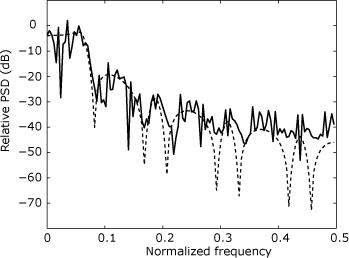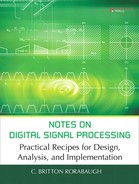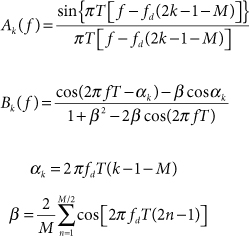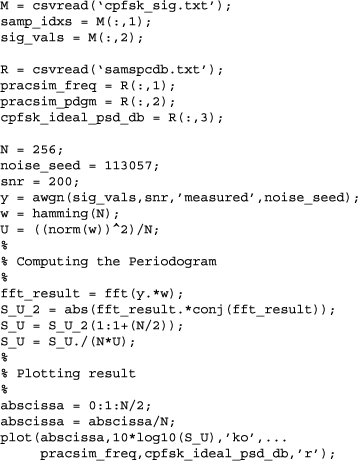Note 28. Exploring Periodogram Performance: Modulated Communications Signals
This note demonstrates the performance of the unmodified periodogram when it is used to estimate the spectrum of a continuous-phase frequency shift keyed (CPFSK) signal. This signal has nulls in its spectrum, but these nulls are not evident in the periodogram.
The utility of a spectrum estimation technique should not be judged solely on the technique’s ability to resolve closely spaced sinsoidal components. This note applies the unmodified periodogram technique to a binary CPFSK signal. The random nature of the data signal used to modulate the CPFSK signal helps to highlight how the unmodified periodogram’s high variance has a weakness in dealing with signals that are inherently random, even when there is no noise added to the signal.
The properties of CPFSK signals are summarized in Math Box 28.1. A PracSim simulation [1] was used to generate a 256-sample segment of a binary CPFSK signal with a symbol duration of Tsymb= 8, a sampling interval of Tsamp = 1, and a peak frequency deviation of fd = 0.04375.
• The segment of MATLAB code in Computer Listing 28.1 computes the unmodified periodogram for the CPFSK signal that was generated by PracSim and written to the file cpfsk_sig.txt. The MATLAB code also plots the theoretical power spectral density (PSD) from Eq. (MB 28.1) that has been pre-computed and stored in the file samspcdb.txt. The resulting plot is shown in Figure 28.1.
Figure 28.1. Periodogram result for CPFSK signal. The dashed trace is the theoretical PSD, and the solid trace is the corresponding unmodified periodogram.

• The noise-like variations in the periodogram plotted in Figure 28.1 are a consequence of using a single sample function to estimate the statistics across the ensemble of all possible data sequences that could drive the CPFSK modulator. These variations can be reduced by using a modified periodogram technique, such as the Bartlett periodogram discussed in Note 30, that averages over multiple sample functions.
Reference
1. C. B. Rorabaugh, Simulating Wireless Communication Systems: Practical Models in C++, Prentice Hall, 2004.


